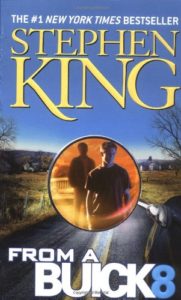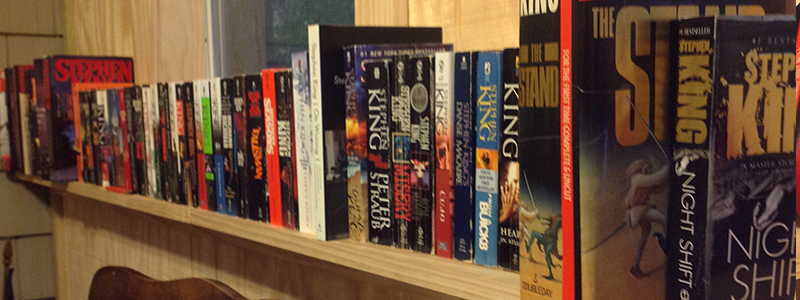by Jay Wilburn
The plan is to reread all of Stephen King’s works in the order that they were published. Richard Chizmar of Cemetery Dance had the vision. I’m doing it because I am a writer and I want to improve my fiction. And I love Stephen King’s stories. I think there is something to be learned through this process.
You can also go back to the beginning and read Before Carrie or any of my other posts up through this one and beyond by checking out this link to the Master List of all my #StephenKingRevisited posts.

As we settle into From A Buick 8, we are introduced to a high school aged son of a police officer as the boy is dealing with his father’s dead by finding ways to be helpful around his late father’s old barracks. As he becomes one of them in his own way, they share the secret history of the mysterious thing hidden in Shed B. That is enough to carry us through the whole novel and it does the job well. The boy is said to be of a “Hamlet age.” That is a great description, pregnant with meaning.
I don’t think a lot of people know this novel very well. If it had come out at the time and in the place of Christine, I imagine critics would have liked it better than they did Christine and maybe it would be just as popular. Who knows? I liked both novels, but I believe I like this one better.
King wrote this novel over a stretch of 3 years from 1999 through 2002, bouncing back and forth between points in Florida and Maine with one stop over in Boston. The idea was born at a gas station in Pennsylvania where King almost slid into a river. I believe I understand he wrote the whole first draft prior to his accident with the van and then it sat for a long time. Upon picking it up again, while he was still on a crutch, he spent time with Pennsylvania police officers getting some of the details straight. Apparently, a few of those officers made it into the novel in highly fictionalized forms. The book feels well-grounded in reality, as a result, even with all the strangeness Shed B.
One of the characters collects Beanie Babies in case we are at all confused about the timeframe.
It is well-paced in the beginning, especially for a Stephen King book. The story within a story is handled well. I liked both the present day and events from the past equally. The grief and recovery in the story are beautifully done. Seeking answers that aren’t there with the supernatural underlines the search for answers to an untimely death — all untimely death. “The world rarely finishes its conversations” we are warned later in the novel. King piled on the foreshadowing faster than I could process until I had a list of hinted-at scenes I couldn’t wait to see unfold.
“Unformed, no language thoughts,” is a good descriptor. There is a thermometer mounted in the shed with a not-quite-right car. When the temperature is too low, it isn’t safe to go in. We’re not told why at first, but this is our first clue that something isn’t right with the world.
King is obsessed with orange light at the end of the 20th and the beginning of the 21st century. He used the word “zest” in this novel. The third or fourth time it’s happened over his career.
“Multi-fatality apartment fires don’t make national news unless it is Christmas.” Great line. That line had to come from one of the officers he spoke with.
“Don’t fuck around with the infinite” is a great line on many levels and not a throwaway line at all in this story.
“Dead as an unchurched god” is an incredible turn of phrase.
Things disappear and other things appear, but in no way that might offer a pattern or answers. In one scene, King waits to describe the “thing” in the corner as long as possible and it works. The description of an otherworldly visitation was really good and took me into the scene while ripping me from my comfort zone. Even descriptions of colors were done in a way that made everything wrong with the world in all the right ways.
About halfway through the book, one of the characters throws out a “honeychile” in a conversation. Fine. Might have even been something he witnessed from a black female dispatcher while on his travels. Who knows? It is delivered a little ham-handedly in an otherwise really stellar novel.
King discusses the horror of trespass. He demonstrates it even better. For several books going way back to the beginning of his career in my rereading, I’ve noticed him using this form of horror and I called it the horror of being known. He’s named the tool he’s been using masterfully for decades up to this point. It’s the horror of trespass and that is an infinitely better name for it. And if I learned anything from this novel, it’s don’t fuck with the infinite.
“My Karma ran over my Dogma” on a bumper sticker. Good stuff.
As we must, as we know we must, we get delivery on a new action in the present of the novel to justify the telling of this secret history of Troop D’s Shed B and to pay off on that drop in temperature we saw at the beginning. In a novel that promises no answers, we are granted a rare glimpse into the other side of things. We’re given enough clues and hints at answers and outcomes to satisfy the hunger this story put into us. We are rewarded this time for trusting an author we should have learned to trust with a story long ago.
A satisfying ending winds up this story as the characters have to wait out what remains of the threat. Can they though? Maybe … and maybe not.
That would have been a good enough ending, but there’s one more scene to play out and the book is better for having it. The author was feeling very generous this time and did not overplay his hand. So, is it done now? Sooner or later.
I appreciate this book the more I talk about it. It’s one of Stephen King’s hidden jewels.
My next post in this series will be Before Wolves of the Calla which will be linked on the Master List of all my Stephen King Revisited posts.





